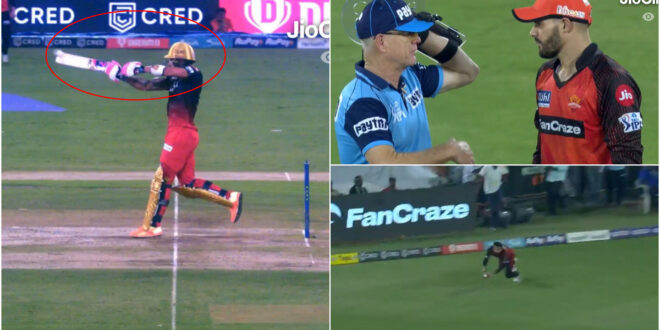In a thrilling cricket encounter, the match between two fierce rivals took anunexpected turn when a seemingly remarkable catch turned out to be futile due to anunfortunate no-ball. The incident occurred during the encounter between NitishReddy and Faf du Plessis, leaving spectators and players alike in a state of disbelief.

As Nitish Reddy steamed in to deliver the ball, du Plessis anticipated a short delivery and went for the pull shot with immense power. The connection was solid, and the ball soared towards the boundary. However, Dagar, stationed at deep mid-wicket, sprinted in, judging the trajectory and speed of the ball. With great agility and anticipation, he managed to grasp the ball, sending shockwaves through the stadium.
The crowd erupted, the fielders celebrated, and the bowler joined in the jubilation.But amidst the euphoria, the umpire’s raised arm signalling a no-ball silenced the celebrations. The catch that was hailed as a game-changer suddenly became null and void.
The third umpire, upon reviewing the footage, declared that Nitish Reddy had overstepped, denying the dismissal and awarding du Plessis another life.The impact of this decision was significant. Faf du Plessis, a seasoned campaigner, was known for his ability to capitalize on opportunities.
His survival meant that the opposition would now have to contend with him for a longer duration, a daunting prospect for any bowling attack. The momentum swung heavily in favour of du Plessis’ team, as they gained a vital reprieve and a chance to further consolidate their position.The ramifications of a no-ball dismissal reverberate beyond the immediate play.
It not only impacts the morale of the fielding team but also alters the course of the match. The psychological blow suffered by the bowler, Nitish Reddy, could affect his subsequent deliveries and overall performance.
The incident also fuels the debate on the role of technology in decision-making, with fans and experts questioning the accuracy and consistency of umpiring decisions.Cricket is a game that thrives on uncertainties and twists of fate. The dramasurrounding du Plessis’ escape through a no-ball further amplifies the intrigue of thesport.
It serves as a reminder that even the most straightforward situations can giveway to unexpected twists, leaving fans on the edge of their seats.While du Plessis was granted a reprieve, the incident sparked intense discussionsamong cricket enthusiasts. Some debated the need for stricter adherence to bowlingregulations, while others argued for a reevaluation of the rules governing no-balldismissals.
In the end, the no-ball call proved to be a game-changer, granting du Plessis another opportunity to showcase his prowess. As the match progressed, the consequences of that fateful decision became apparent, leaving everyone to ponder the role such incidents play in shaping the outcome of a game.
The incident will be etched in thememories of fans and players alike, serving as a reminder of the fine margins that separate triumph from despair in this beautiful game.
 CricSpirit Where The Game Starts
CricSpirit Where The Game Starts



